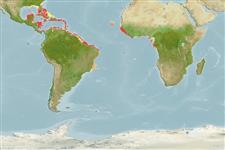Common names from other countries
Environment: milieu / climate zone / depth range / distribution range
Sinh thái học
Cùng sống ở rạn san hô; Mức độ sâu 0 - 30 m (Ref. 848). Subtropical; 33°N - 25°S, 92°W - 12°E (Ref. 848)
Atlantic Ocean.
Length at first maturity / Bộ gần gũi / Khối lượng (Trọng lượng) / Age
Maturity: Lm ? range ? - ? cm Max length : 5.0 cm COLD con đực/không giới tính; (Ref. )
Colony: small, usually less than 50 mm across, hemispherical to encrusting. Corallites: shape range from immersed to conical to tubular, may be circular with one mouth, to elongate with multiple mouths; intertidal encrusting colonies may be submeandroid; spherical colonies with unrestricted growing space often with tubular corallites; valleys seldom more than 5 mm across; walls neatly rounded, whatever the corallite shape. Septo-costae exsert and evenly spaced. Color: often tan to light orange-brown with pale green tentacles (Ref. 848).
Zooxanthellate (Ref. 116012). Common in shallow less than 15 m; reef habitats and sometimes seagrass beds (Ref. 415). Also in intertidal rock pools and shallow reef environments (Ref. 848).
Life cycle and mating behavior
Chín muồi sinh dục | Sự tái sinh sản | Đẻ trứng | Các trứng | Sự sinh sản | Ấu trùng
Hermaphroditic (Ref. 113712). Mature gametes are shed into the coelenteron and spawned through the mouth. Life cycle: The zygote develops into a planktonic planula larva. Metamorphosis begins with early morphogenesis of tentacles, septa and pharynx before larval settlement on the aboral end (Ref. 833).
Collin, R., M.C. Díaz, J. Norenburg, R.M. Rocha, J.A. Sánchez, M. Schulze, A. Schwartz and A. Valdés. 2005. (Ref. 415)
IUCN Red List Status (Ref. 130435)
CITES status (Ref. 108899)
Not Evaluated
Human uses
| FishSource |
Các công cụ
Thêm thông tin
Age/SizeSự sinh trưởngLength-weightLength-lengthHình thái họcẤu trùngSự phong phú
Các nguồn internet
Estimates based on models
Preferred temperature
(Ref.
115969): 26.2 - 28.1, mean 27.5 (based on 798 cells).
Price category
Unknown.
